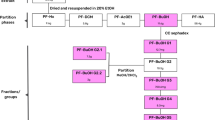Abstract
The aim of this study was to evaluate the phytochemical constituents, antioxidant, antifungal, and anti-virulence activities of traditionally used Mezoneuron benthamianum leaves. Extracts were prepared using acetone and methanol, and the preliminary phytochemical screening was performed. The antioxidant activity was studied using the DPPH method. Anti-Candida albicans activity was established and the effect on the germ tube and phospholipase production, as well as on the host cell adherence was assessed. The extracts showed the presence of anthraquinones, cardiac glycosides, flavonoids, reducing sugars, saponins, steroids, tannins, and terpenoids. Gallic acid and trans-resveratrol were among the predominant phytochemicals found in M. benthamianum. The crude extracts presented significantly higher antioxidant activity than the ascorbic acid standard. At 0.39 mg/mL, acetone extract inhibited the growth of Candida albicans. At lower concentrations (200–50 µg/mL), it significantly inhibited the adherence ability (up to 51%), formation of hyphae (up to 65%), and the production of phospholipase. In conclusion, at high concentrations, M. benthamianum kills C. albicans, and at lower concentrations, it can inhibit the virulence properties of this pathogen. This study on crude extract validates the traditional use of this plant. However, further research is required to establish the anti-virulence activity of the two compounds and their therapeutic potential.







Similar content being viewed by others
References
Ademoye MA, Lajide L, Owolabi BJ (2018) Phytochemical and antioxidants screening of Chrysophyllum albidum, Mezoneuron benthamianum, Phyllanthus muellerianus and Acalypha fimbriata. Int J Sci 7:8–18. https://doi.org/10.18483/ijsci.1803
Ahmad A, Molepo J, Patel M (2016) Challenges in the development of antifungal agents against Candida: scope of phytochemical research. Curr Pharm Des 22:1–16
Aiyelaagbe OO, Osamudiamen PM (2009) Phytochemical Screening for Active Compounds in Mangifera indica leaves from Ibadan. Oyo State Plant Sci Res 2(1):11–13
Binutu OA, Cordell GA (2000) Gallic Acid derivatives from Mezoneuron benthamianum leaves. Pharm Biol 38(4):284–286. https://doi.org/10.1076/1388-0209(200009)3841-AFT284
Burkill HM (1985) The useful plants of West Tropical Africa, vol 4. Royal Botanic Gardens, Kew, University Press of Virginia, Charlottesville, VA
Cowen LE, Sanglard D, Howard SJ, Rogers PD, Perlin DS (2014) Mechanisms of antifungal drug resistance. Cold Spring Harb Perspect Med 5(7):a019752. https://doi.org/10.1101/cshperspect.a019752
Dantas Ada S, Day A, Ikeh M, Kos I, Achan B, Quinn J (2015) Oxidative stress responses in the human fungal pathogen Candida albicans. Biomolecules 5(1):142–165. https://doi.org/10.3390/biom5010142
de Groot PWJ, Bader O, de Boer AD, Weig M, Chauhan N (2013) Adhesins in human fungal pathogens: glue with plenty of stick. Eukaryot Cell 12(4):470–481. https://doi.org/10.1128/EC.00364-12
Dickson RA, Annan K, Komlaga G (2011) Pharmacognostic standardization of the leaves and root bark of Caesalpinia benthamiana. Pharmacognosy Res 3(24):31–34. https://doi.org/10.5530/pj.2011.24.6
Dickson RA, Annan K, Fleischer TC, Houghton PJ (2012) Benthaminin 3, a novel antibacterial cassane-type furanoditerpenoid from Caesalpinia benthamiana. J Pharm Nutr Sci 2:21–26
Eloff JN (1999) The antibacterial activity of 27 southern African members of the Combretaceae. S Afr J Sci 95:148–152
Fayemi SO, Osho A, Atolani O (2012) In vitro anticandidal and antioxidant potential of Mezoneuron benthamianum. J Acute Dis 1(2):120–125. https://doi.org/10.1016/S2221-6189(13)60028-1
Harborne JB (1973) Phytochemical methods. A guide to modern techniques of plant analysis, 3rd edn. Chapman and Hall, London, Weinheim, New York, Tokyo, Melbourne, Madras
Jansen O, Tchinda AT, Loua J, Esters V, Cieckiewicz E, Ledoux A, Toukam PD, Angenot L, Tits M, Balde AM, Frédérich M (2017) Antiplasmodial activity of Mezoneuron benthamianum leaves and identification of its active constituents. J Ethnopharmacol 203:20–26. https://doi.org/10.1016/j.jep.2017.03.021
Jung HJ, Young BS, Dong GL (2007) Candicidal action of resveratrol isolated from grapes on human pathogenic yeast C. albicans. J Microbiol Biotechnol 17(8):1324–1329
Kazuko O-S, Sato Y, Azyma T (2010) Resveratrol impaired the morphological transition of Candida albicans under various hyphae-inducing conditions. J Microbiol Biotechnol 20(5):942–945. https://doi.org/10.4014/jmb.0911.11014
Lee J, Lee DG (2015) Novel antifungal mechanism of resveratrol: apoptosis inducer in Candida albicans. Curr Microbiol 70:383–389. https://doi.org/10.1007/s00284-014-0734-1
Leidich SD, Ibrahim AS, Fu Y, Jessup C, Vitullo J, Fonzi W, Mirbod F, Nakashima S, Nozawa Y, Ghannoum MA (1998) Cloning and disruption of caPLB1, a phospholipase B gene involved in the pathogenicity of Candida albicans. J Biol Chem 278:26078–26086
Li Z-J, Liu M, Dawuti G, Dou Q, Ma Y, Liu H-G, Aibai S (2017) Antifungal activity of gallic acid in vitro and in vivo. Phytother Res 31:1039–1045. https://doi.org/10.1002/ptr.5823
Loua J, Traore MS, Camara A, Balde MA, Maes L, Pieters L, Balde AM (2017) Biological and phytochemical investigations on Caesalpinia benthamiana, a plant traditionally used as antimalarial in Guinea. Evid Based Complement Alternat Med 2017:9438607. https://doi.org/10.1155/2017/9438607
Mishra NN, Prasad T, Sharma N, Payasi A, Prasad R, Gupta DK, Singh R (2007) Pathogenicity and drug resistance in Candida albicans and other yeast species. Acta Microbiol Immunol Hung 54(3):201–235
Naicker SD, Patel M (2013) Dodonaea viscosa var. angustifolia Inhibits germ tube and biofilm formation by C. albicans. Evid Based Complement Alternat Med. 2013:261978. https://doi.org/10.1155/2013/261978
Nobile CJ, Nett JE, Andes DR, Mitchell AP (2006) Function of Candida albicans adhesin Hwp1 in biofilm formation. Eukaryot Cell. 5(10):1604–1610
Osamudiamen PM, Aiyelaagbe OO, Koul S, Sangwan PL, Vaid S, Saxena AK (2017) Isolation, characterization, and in-vitro anti-Cancer activity of bioactive Cassane diterpenoids from the roots of Mezoneuron benthamianum (Baill.). J Biol Active Prod Nat 7(3):157–165. https://doi.org/10.1080/22311866.2017.1335232
Osamudiamen PM, Oluremi BB, Oderinlo OO, Aiyelaagbe OO (2020) Trans-resveratrol, piceatannol and gallic acid: Potent polyphenols isolated from Mezoneuron benthamianum effective as anticaries, antioxidant and cytotoxic agents. Sci Afr 7:e00244. https://doi.org/10.1016/j.sciaf.2019.e00244
Osho A (2014) Ethnopharmacological properties of Ceasalpinia benthamiana—a mini review. Br Microbiol Res J 4(2):206–213
Patel M, Gulube Z, Dutton M (2009) The effect of Dodonaea viscosa var. angustifolia on Candida albicans proteinase and phospholipase production and adherence to oral epithelial cells. J Ethnopharmacol 124(3):562–565. https://doi.org/10.1016/j.jep.2009.05.002
Patel M, Srivastava S, Ahmad A (2020) Dodonaea viscosa var. angustifolia derived 5,6,8-trihydroxy-7,4′ dimethoxy flavone inhibits ergosterol synthesis and the production of hyphae and biofilm in Candida albicans. J Ethnopharmacol 259:112965
Pusateri CR, Monaco EA, Edgerton M (2009) Sensitivity of Candida albicans biofilm cells grown on denture acrylic to antifungal proteins and chlorhexidine. Arch Oral Biol 54(6):588–594. https://doi.org/10.1016/j.archoralbio.2009.01.016
Ren T, Zhu H, Tian L, Yu Q, Li M (2019) Candida albicans infection disturbs redox homeostasis system and induces reactive oxygen species accumulation for epithelial cell death. FEMS Yeast Res. https://doi.org/10.1093/femsyr/foz081
Ruchel R, Tegeler R, Trost MA (1982) Comparison of secretory proteinase from different strains of Candida albicans. Sabouraudia 20:233–244
Silva-Rocha WP, de Brito Lemos VL, Ferreira MR, Soares LA, Svidzisnki TI, Milan EP, Chaves GM (2015) Effect of the crude extract of Eugenia uniflora in morphogenesis and secretion of hydrolytic enzymes in Candida albicans from the oral cavity of kidney transplant recipients. BMC Complement Altern Med 15:6. https://doi.org/10.1186/s12906-015-0522-x
Teodoro GR, Gontijo AVL, Salvador MJ, Tanaka MH, Brighenti FL, Delbem ACB, Koga-Ito CY (2018) Effects of acetone fraction from Buchenavia tomentosa aqueous extract and gallic Acid on Candida albicans biofilms and virulence factors. Front Microbiol 9:647. https://doi.org/10.3389/fmicb.2018.00647
Acknowledgements
OPM and OOO appreciate the Principal Technologist, Mrs A.E. Ayano, and the entire staff of the Central Teaching Laboratory of Bells University of Technology for the permission to use their facilities.
Author information
Authors and Affiliations
Contributions
NS performed some of the laboratory experiments and data analysis, GZ, OOO, and IKC performed some of the laboratory experiments, OPM and PM conceptualized the research project, coordinated the investigations, and prepared manuscript.
Corresponding author
Ethics declarations
Conflict of interest
The authors declare that they have no conflict of interest.
Additional information
Communicated by Erko Stackebrandt.
Publisher's Note
Springer Nature remains neutral with regard to jurisdictional claims in published maps and institutional affiliations.
Electronic supplementary material
Below is the link to the electronic supplementary material.
Rights and permissions
About this article
Cite this article
Nciki, S., Oderinlo, O.O., Gulube, Z. et al. Mezoneuron benthamianum inhibits cell adherence, hyphae formation, and phospholipase production in Candida albicans. Arch Microbiol 202, 2533–2542 (2020). https://doi.org/10.1007/s00203-020-01972-2
Received:
Revised:
Accepted:
Published:
Issue Date:
DOI: https://doi.org/10.1007/s00203-020-01972-2




